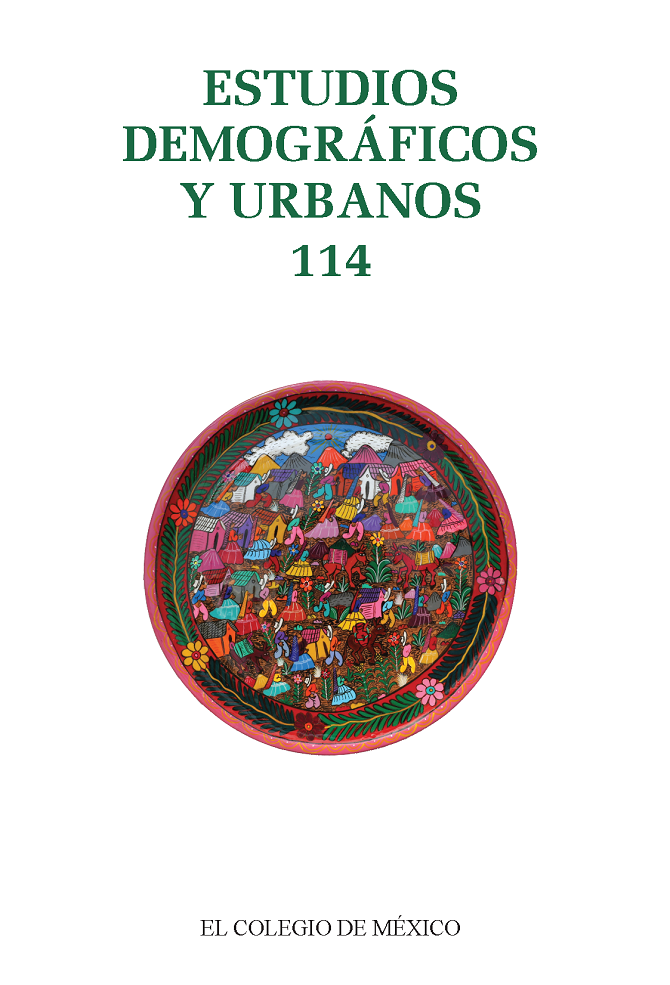Delimitation and paths of the metropolitan areas in Mexico, 1990-2020
Published 2023-09-19
Keywords
- urban agglomeration,
- metropolitan area,
- criteria for the delimitation of metropolitan areas,
- metropolitan dynamics,
- intrametropolitan distribution of population and employment
How to Cite
-
Abstract2312
-
PDF (español)1202
-
En línea (español)378
-
EPUB (español)19
-
Kindle (español)42
-
Audio (español)34
Downloads
Copyright (c) 2022 Estudios Demográficos y Urbanos

This work is licensed under a Creative Commons Attribution-NonCommercial-NoDerivatives 4.0 International License.
Metrics
Abstract
This article discusses metropolitan development in Mexico and presents a methodological proposal for the delimitation of the country’s metropolitan areas in 2020. The reflection refers to the patterns of territorial distribution of the population, while the proposal follows criteria and considerations that have been used in the country and in other latitudes of the planet. The result of the empirical exercise shows a total of 62 metropolitan areas in 2020, covering 338 municipalities. The conformation of these metropolitan areas is mainly for reasons of physical union and, to a lesser extent, by functional relationship. Subsequently, an analysis is made on the temporal evolution of these metropolises between 1990 and 2020, and their spatial configuration. This exercise allows having a definition of metropolitan areas for 1990, 2000, 2010 and 2020 based on uniform criteria. Later, the demographic dynamics of metropolitan areas between 1990 and 2020 are studied. Finally, the patterns of intrametropolitan distribution of the population and employment, and their change over time, are reviewed. The importance of this exercise is to review the definition and characteristics of metropolitan areas in Mexico based on approved criteria for their delimitation, the demographic and occupational distribution within metropolitan areas, and the challenges faced by the government and administration of these urban agglomerations.
References
- Alarcón, E. (2000). Estructura urbana en ciudades fronterizas: Nuevo Laredo-Laredo, Reynosa-McAllen, Matamoros-Brownsville. Tijuana: El Colegio de la Frontera Norte.
- Alegría, T. (2009). Metrópolis transfronteriza: revisión de la hipótesis y evidencias de Tijuana, México, y San Diego, Estados Unidos. Tijuana: El Colegio de la Frontera Norte.
- Álvarez, G. (2017). Morfología y estructura urbana en las ciudades medias mexicanas. Región y Sociedad, 29(68), 153-191. https://www.scielo.org.mx/pdf/regsoc/v29n68/1870-3925-regsoc-29-68-00153.pdf DOI: https://doi.org/10.22198/rys.2017.68.a872
- Arellano, A. (2014). La coordinación metropolitana en el ámbito subnacional mexicano: un análisis institucional. Documentos y Aportes en Administración Pública y Gestión Estatal, 14(23), 33-70. https://www.redalyc.org/pdf/3375/337539189002.pdf DOI: https://doi.org/10.14409/da.v0i24.4765
- Balchin, P., Isaac, D. y Chen, J. (2000). Urban Economics. Londres: Palgrave. DOI: https://doi.org/10.1007/978-1-137-06223-9
- Becerril, C. (2019). Conceptualización y características de lo metropolitano en América Latina. En I. Orihuela (coord.), Dinámicas metropolitanas (pp. 17-33). Ciudad de México: Instituto Mora.
- Bluestone, B., Stevenson, M. y Williams, R. (2008). The urban experience. Oxford: Oxford University Press.
- Boix, R., Veneri, P. y Almenar, V. (2012). Polycentric metropolitan areas in Europe: Towards a unified proposal of delimitation. En E. Fernández y F. Rubiera (eds.), Defining the spatial scale in modern regional analysis (pp. 45-70). Heidelberg: Springer. DOI: https://doi.org/10.1007/978-3-642-31994-5_3
- Coulter, R., vaan Ham, M. y Findlay, A. (2016). Re-thinking residential mobility: Linking lives through time and space. Progress in Human Geography, 40(3), pp. 352-374. https://journals.sagepub.com/doi/pdf/10.1177/0309132515575417 DOI: https://doi.org/10.1177/0309132515575417
- Cox, K. (2002). Political geography. Oxford: Blackwell Publishing. DOI: https://doi.org/10.1002/9780470693629
- Delmelle, E. (2017). Differentiating pathways of neighborhood change in 50 U.S. metropolitan areas. Environmental and Planning A, 49(10), 2402-2424. https://doi.org/10.1177/0308518X17722564?journalCode=epna DOI: https://doi.org/10.1177/0308518X17722564
- Dijkstra, L., Poelman, H. y Veneri, P. (2019). The EU-OECD definition of a functional urban area. París: Organisation for Economic Cooperation and Development. https://shorturl.at/FJTV8
- Fujita, M. (1989). Urban economic theory. Cambridge: Cambridge University Press. DOI: https://doi.org/10.1017/CBO9780511625862
- García, M. Á., Viladecans, E. y Hémet, C. (2017). How does transportation shape intrametropolitan growth? An answer from the Regional Express Rail. Journal of Regional Science, 57(5), 758-780. https://doi.org/10.1111/jors.12338 DOI: https://doi.org/10.1111/jors.12338
- Goodall, B. (1987). Dictionary of human geography. Londres: Penguin Books.
- Gottdiener, M., Budd, L. y Lehtovouri, P. (2016). Key concepts in urban studies. Los Ángeles: Sage.
- Jin, Y., Ling, L., Peng, H. y Song, P. (2013). Fiscal decentralization and horizontal fiscal inequality in China. The Chinese Economy, 46(3), 6-22. https://shorturl.at/ABNX8 DOI: https://doi.org/10.2753/CES1097-1475460301
- Latham, A., McCormack, D., McNamara, K. y McNeill, D. (2009). Key concepts in urban geography. Los Ángeles: Sage. DOI: https://doi.org/10.4135/9781446214404
- Lee, S. (2011). Metropolitan growth patterns and socio-economic disparity in six US metropolitan areas 1970-2000. International Journal of Urban and Regional Research, 35(5), 988-1011. https://onlinelibrary.wiley.com/doi/epdf/10.1111/j.1468-2427.2010.01004.x DOI: https://doi.org/10.1111/j.1468-2427.2010.01004.x
- Lezama, J. L. (2014). Teoría social, espacio y ciudad. Ciudad de México: El Colegio de México, A.C.
- Liu, L., Dong, X. y Chi, S. (2010). Quantitative delimitation of metropolitan areas based on a synthetic method: Case study in the Lanzhou metropolitan area. Journal of Urban Planning and Development, 136(4), 357-364. https://ascelibrary.org/doi/full/10.1061/%28ASCE%29UP.1943-5444.0000029 DOI: https://doi.org/10.1061/(ASCE)UP.1943-5444.0000029
- Liu, T. y Shi, Q. (2020). Acquiring a Beijing hukou: Who is eligible and who is successful? The China Quarterly, 243, 855-868. https://shorturl.at/qGILO DOI: https://doi.org/10.1017/S0305741019001541
- Marmolejo, C. y Batista, N. (2011). Estructura urbana y segregación sociorresidencial: un análisis para Maceió-Alagoas, Brasil. Papeles de Población, 17(70), 247-286. https://www.scielo.org.mx/pdf/pp/v17n70/v17n70a10.pdf
- Metropolitan Policy Program. (2010). State of Metropolitan America. Washington: Brookings. www.brookings.edu/wp-content/uploads/2016/06/metro_america_report.pdf
- Mills, E. y Hamilton, B. (1994). Urban economics. Nueva York: Harper Collins College.
- Millward, H. y Bunting, T. (2008). Patterning in urban population densities: A spatio-temporal model compared with Toronto 1971-2001. Environment and Planning, 40(2), 283-302. https://journals.sagepub.com/doi/pdf/10.1068/a38498 DOI: https://doi.org/10.1068/a38498
- Narayana, M. (2009). Size distribution of metropolitan areas: Evidence and implications for India. Margin: The Journal of Applied Economics Research, 3(3), 243-264. https://journals.sagepub.com/doi/10.1177/097380100900300303 DOI: https://doi.org/10.1177/097380100900300303
- Negrete, M. E. y Salazar, H. (1986). Zonas metropolitanas en México, 1980. Estudios Demográficos y Urbanos, 1(1), 97-124. https://www.jstor.org/stable/40314469 DOI: https://doi.org/10.24201/edu.v1i1.571
- Ong, L. (2014). State-led urbanization in China: Skyscrapers, land revenue and concentrated villages. The China Quarterly, 217, 162-179. https://papers.ssrn.com/sol3/papers.cfm?abstract_id=2357143 DOI: https://doi.org/10.1017/S0305741014000010
- Orihuela, I. y Sobrino, J. (2019). Conformación e importancia de las zonas metropolitanas. En J. Sobrino y V. Ugalde (eds.), Desarrollo urbano y metropolitano en México (pp. 79-118). Ciudad de México: El Colegio de México, A.C. DOI: https://doi.org/10.2307/j.ctvqmp2m5.5
- Pacione, M. (2009). Urban geography. A global perspective. Londres: Routledge. DOI: https://doi.org/10.4324/9780203881927
- Parker, G. y Doak, J. (2012). Key concepts in planning. Los Ángeles: Sage. DOI: https://doi.org/10.4135/9781473914629
- Pinto da Cunha, J. M. y Rodríguez, J. (2009). Crecimiento urbano y movilidad en América Latina. Revista Latinoamericana de Población, 3(4-5), 27-64. https://www.redalyc.org/pdf/3238/323827368003.pdf DOI: https://doi.org/10.31406/relap2009.v3.i1.n4-5.1
- Robinson, G. (1998). Methods and techniques in human geography. Chichester: John Wiley & Sons.
- Rossi, P. (1980). Why families move. Beverly Hills, CA: Sage.
- Secretaría de Desarrollo Agrario, Territorial y Urbano, Consejo Nacional de Población e Instituto Nacional de Estadística y Geografía. (2018). Delimitación de las zonas metropolitanas de México 2015. Ciudad de México. https://www.gob.mx/conapo/documentos/delimitacion-de-las-zonas-metropolitanas-de-mexico-2015
- Secretaría de Desarrollo Social. (2011). La expansión urbana de las ciudades, 1980-2010. Ciudad de México. https://www.academia.edu/30672852/_La_expansi%C3%B3n_de_las_ciudades_1980_2010_por_SEDESOL
- Secretaría de Desarrollo Social, Consejo Nacional de Población e Instituto Nacional de Estadística y Geografía. (2012). Delimitación de las zonas metropolitanas de México, 2010. Ciudad de México. https://www.gob.mx/conapo/documentos/delimitacion-de-las-zonas-metropolitanas-de-mexico-2010
- Secretaría de Desarrollo Social, Consejo Nacional de Población e Instituto Nacional de Estadística, Geografía e Informática. (2004). Delimitación de las zonas metropolitanas de México. Ciudad de México. https://www.inegi.org.mx/contenidos/productos/prod_serv/contenidos/espanol/bvinegi/productos/historicos/1329/702825010048/702825010048_1.pdf
- Secretaría de Desarrollo Social, Consejo Nacional de Población e Instituto Nacional de Estadística, Geografía e Informática. (2007). Delimitación de las zonas metropolitanas de México 2005. Ciudad de México. http://www.conapo.gob.mx/work/models/CONAPO/zonas_metropolitanas/completoZM2005.pdf
- Sikarwar, A. y Chattopadhyay, A. (2020). Analyzing population and land use change. Selected case studies of Indian metropolitan cities. Singapur: Springer. DOI: https://doi.org/10.1007/978-981-15-5036-2
- Sobrino, J. (1993). Gobierno y administración metropolitana y regional. Ciudad de México: Instituto Nacional de Administración Pública.
- Sobrino, J. (2016). Dinámica y distribución territorial de la población en México. En M. E. Negrete (coord.), Urbanización y política urbana en Iberoamérica (pp. 61-105). Ciudad de México: El Colegio de México, A.C.
- Sobrino, J. (2020). Migración interestatal e intermunicipal en México. En S. Giorguli y J. Sobrino (eds.), Dinámica demográfica de México en el siglo XXI. Tomo II (pp. 47-83). Ciudad de México: El Colegio de México, A.C.
- Tamayo, S. (coord.) (2007). Los desafíos del Bando 2: evaluación multidimensional de las políticas habitacionales en el Distrito Federal, 2000-2006. Ciudad de México: Universidad Autónoma de la Ciudad de México / Secretaría de Desarrollo Urbano y Vivienda.
- Tsai, Y. (2005). Quantifying urban form: Compactness versus sprawl. Urban Studies, 42(1), 141-161. https://journals.sagepub.com/doi/10.1080/0042098042000309748 DOI: https://doi.org/10.1080/0042098042000309748
- Ugalde, V. (2007). Sobre el gobierno en las zonas metropolitanas de México. Estudios Demográficos y Urbanos, 22(2), 443-460. https://www.scielo.org.mx/pdf/educm/v22n2/2448-6515-educm-22-02-443.pdf DOI: https://doi.org/10.24201/edu.v22i2.1285
- Unikel, L., Ruiz, C. y Garza, G. (1978). El desarrollo urbano de México. Ciudad de México: El Colegio de México, A.C.
- United Nations. (2021). World Urbanization Prospects 2018, Urban Agglomerations. https://population.un.org/wup/Download/
- U.S. Bureau of the Census. (1959). Census areas of l950. En M. Harold y C. Kohn (eds.), Readings in urban geography (pp. 29-32). Chicago: The University of Chicago Press.
- U.S. Bureau of the Census. (2003). Metropolitan and micropolitan statistical areas. Washington: Government Printing Office.


